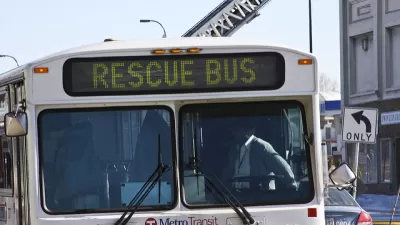Equity illuminates the light at the end of the tunnel for U.S. transit agencies, according to a recent report by the Urban Institute.

The Urban Institute and the American Public Transportation Association's Center for Neighborhood Technology this week published a new study that tracks the efforts of North American public transit agencies planning a return to regular activity.
A pair of articles published on the Urban Institute website introduce the new study and introduce key concepts for the research, such as ridership trends and equity-centering responses.
According to the first article, written by Jorge Morales-Burnett and Yonah Freemark, "Equity had a major role in how some agencies responded, and they offer lessons for how others can prioritize equity as we recover from the pandemic." The article notes a particularly salient example from Denver, where "transit ridership actually increased over the pandemic in neighborhoods with relatively low incomes (median household incomes of $35,000 or less), while it declined in wealthier neighborhoods (median household incomes of $55,000 or more)."
The article also notes that interviews with transit workers revealed how staff gained new awareness about equity during the pandemic. "One agency CEO noted, 'We recognized through COVID that transit is critical... [that it is] a lifeline service for people. We need to rethink the model,'" according to the article.
Some of the responses by transit agencies that accounted for equity included increased local service and decreased express service (particularly from more suburban areas to downtown cores or suburban tech hubs). This trend made the news on Planetizen in November 2020, when the Massachusetts Bay Transportation Authority announced plans to cut commuter rail and focus on bus service.
The second article, also written by Morales-Burnett and Freemark, digs more into the details of how transit agencies are ramping back up to normal, pre-pandemic service levels. According to Morales-Burnett and Freemark, returning to normal will require transit agencies to provide effective, equity focused transit service. The article includes a list of best practices for achieving that goal.
Not mentioned in the article, but material to the goals of transit agencies for getting back on track, is an ongoing driver shortage, which is affecting service and operations in more cities with every passing week. The issue is significant enough that TransitCenter this week Tweeted that the driver shortage is the biggest challenge facing transit agencies at the end of the second year of the pandemic—a notable shift from the funding crises of the beginning of 2020, but an existential threat nonetheless.
FULL STORY: The Ways Transit Agencies Adapted during the Pandemic Can Inform an Equitable Recovery

Alabama: Trump Terminates Settlements for Black Communities Harmed By Raw Sewage
Trump deemed the landmark civil rights agreement “illegal DEI and environmental justice policy.”

Planetizen Federal Action Tracker
A weekly monitor of how Trump’s orders and actions are impacting planners and planning in America.

How Atlanta Built 7,000 Housing Units in 3 Years
The city’s comprehensive, neighborhood-focused housing strategy focuses on identifying properties and land that can be repurposed for housing and encouraging development in underserved neighborhoods.

In Both Crashes and Crime, Public Transportation is Far Safer than Driving
Contrary to popular assumptions, public transportation has far lower crash and crime rates than automobile travel. For safer communities, improve and encourage transit travel.

Report: Zoning Reforms Should Complement Nashville’s Ambitious Transit Plan
Without reform, restrictive zoning codes will limit the impact of the city’s planned transit expansion and could exclude some of the residents who depend on transit the most.

Judge Orders Release of Frozen IRA, IIJA Funding
The decision is a victory for environmental groups who charged that freezing funds for critical infrastructure and disaster response programs caused “real and irreparable harm” to communities.
Urban Design for Planners 1: Software Tools
This six-course series explores essential urban design concepts using open source software and equips planners with the tools they need to participate fully in the urban design process.
Planning for Universal Design
Learn the tools for implementing Universal Design in planning regulations.
Caltrans
Smith Gee Studio
Institute for Housing and Urban Development Studies (IHS)
City of Grandview
Harvard GSD Executive Education
Toledo-Lucas County Plan Commissions
Salt Lake City
NYU Wagner Graduate School of Public Service





























